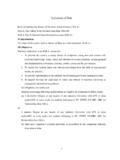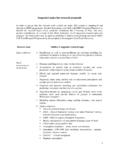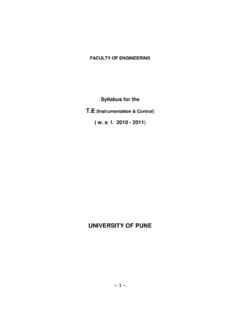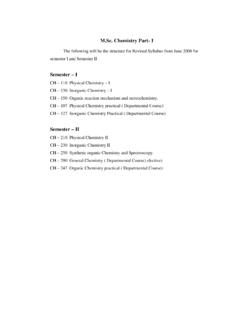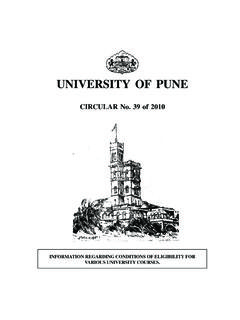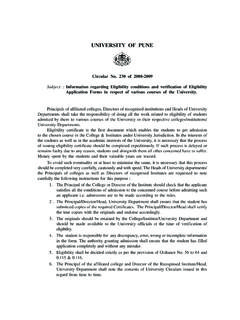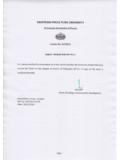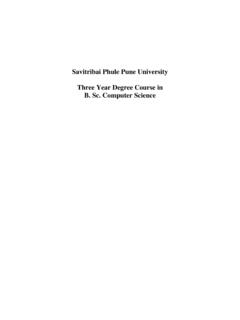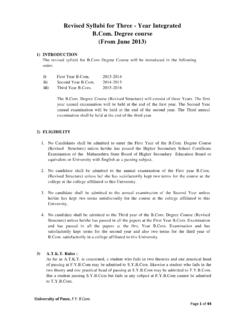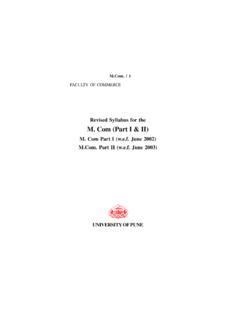Transcription of Savitribai Phule Pune University, Pune
1 Savitribai Phule pune university , pune BE(Electronics & Telecommunication) (2012 course revised syllabus ) ( June 2015) BE (E & TC) Structure 2012 Course June 2015 Semester-I Subject Code Subject Teaching Scheme Examination Scheme Marks LECT TUT PR In Semester Assessment PR OR TW End Semester Examination Total Phase I Phase II 404181 VLSI Design & Technology 3 30 70 100 404182 Computer Networks 3 30 70 100 404183 Microwave Engineering 4 30 70 100 404184 Elective I 3 30 70 100 404185 Elective II 3 30 70 100 404186 Lab Practice I (CN & MWE) 4 50 50 100 404187 Lab Practice II (VLSI &Elective I) 4 50 50 100 404188 Project Phase I 2 50 50 Total 16 2 8 150 50 100 100 350 750 Elective I 1.
2 Digital Image Processing 2. Embedded Systems & RTOS 3. Software Defined Radio 4. Industrial Drives and Control Elective II 1. Multi rate & Adaptive Signal Processing 2. Electronic Product Design 3. PLCs and Automation 4. Artificial Intelligence Semester-II Subject Code Subject Teaching Scheme Examination Scheme Marks LECT TUT PR In Semester Assessment PR OR TW End Semester Examination Total Phase I Phase II 404189 Mobile Communication 4 30 70 100 404190 Broadband Communication Systems 4 30 70 100 404191 Elective III 3 30 70 100 404192 Elective IV 3 30 70 100 404193 Lab Practice III(MC & BCS) 4 50 50 100 404194 Lab Practice IV(Elective III) 2 50 50 100 404195 Project Phase II 6 50 100 150 Total 14 6 6 120 100 50 200 280 750 Elective III 1.
3 Speech & Audio Signal Processing 2. RF Circuit Design 3. Audio Video Engineering 4. Soft Computing Elective IV 1. Biomedical Signal Processing 2. Nano Electronics & MEMS 3. Detection & Estimation theory 4. Wireless Networks 5. Open Elective* *Any one subject from the list of Elective IV of computer/IT/Electrical/Instrumentation or Institute can offer elective IV based on any industry need with prior approval from BoS(Electronics). Repetition of subjects or topics is to be avoided. Dr. D. S. Bormane Chairman, BOS(Electronics) VLSI Design & Technology(404181) Teaching Scheme: Lectures: 3 Hrs/ Week Examination Scheme: In Semester Assessment: Phase I : 30 End Semester Examination: Phase II: 70 Course Objectives: To study HDL based design approach.
4 To learn digital CMOS logic design. To nurture students with CMOS analog circuit designs. To realize importance of testability in logic circuit design. To overview SoC issues and understand PLD architectures with advanced features. Course Outcomes: Aftersuccessfully completing the course, students will be able to Model digital circuit with HDL, simulate, synthesis and prototype in PLDs. Understand chip level issues and need of testability. Design analog & digital CMOS circuits for specified applications. Unit I: VHDL Modeling 7L Data objects, Data types, Entity, Architecture & types of modeling, Sequential statements, Concurrent statements, Packages, Sub programs, Attributes, VHDL Test bench, Test benches using text files.
5 VHDL modeling of Combinational, Sequential logics & FSM, Meta-stability. Unit II: PLD Architectures 7L PROM, PLA, PAL: Architectures and applications. Software Design Flow. CPLD Architecture, Features, Specifications, Applications. FPGA Architecture, Features, Specifications, Applications. Unit III: SoC& Interconnect 6L Clock skew, Clock distribution techniques, clock jitter. Supply and ground bounce, power distribution techniques. Power optimization. Interconnect routing techniques; wire parasitic, Signal integrity issues.
6 I/O architecture, pad design. Architectures for low power. Unit IV: Digital CMOS Circuits 7L MOS Capacitor, MOS Transistor theory , C-V characteristics, Non ideal I-V effects, Technology Scaling. CMOS inverters, DC transfer characteristics, Power components, Power delay product. Transmission gate. CMOS combo logic design. Delays: RC delay model, Effective resistance, Gate and diffusion capacitance, Equivalent RC circuits; Linear delay model, Logical effort, Parasitic delay, Delay in a logic gate, Path logical efforts. Unit V: Analog CMOS Design 7L Current sink and source, Current mirror.
7 Active load, Current source and Push-pull inverters. Common source, Common drain, Common gate amplifiers. Cascode amplifier, Differential amplifier, Operational amplifier. Unit VI: Testability6L Types of fault, Need of Design for Testability (DFT), Testability, Fault models, Path sensitizing, Sequential circuit test, BIST, Test pattern generation, JTAG & Boundary scan, TAP Controller. Text Books 1. Charles H. Roth, Digital systems design using VHDL , PWS. 2. Wyane Wolf, Modern VLSI Design (System on Chip) , PHI Publication. Reference Books 1. Allen Holberg, Analog CMOS Design , Oxford university Press. 2. Neil H. E. Weste, David Money Harris, CMOS VLSI Design: A Circuit & System Perspective , Pearson Publication Computer Networks(404182) Teaching Scheme: Lectures:3 Hrs/ Week Examination Scheme: In Semester Assessment: Phase I : 30 End Semester Examination: Phase II: 70 Course Objectives.
8 Understand state-of-the-art in network protocols, architectures, and applications To provide students with a theoretical and practical base in computer networks issues Define the basic terminology of computer networks Recognize the individual components of the big picture of computer networks Outline the basic network configurations List the layers of the TCP/IP and OSI model and describe the duties of each layer Understand the transmission methods underlying LAN and WAN technologies. Course Outcomes: After successfully completing the course students will be able to Understand fundamental underlying principles of computer networking Describe and analyze the hardware, software, components of a network and the interrelations.
9 Analyze the requirements for a given organizational structure and select the most appropriate networking architecture and technologies; Have a basic knowledge of the use of cryptography and network security; Have a basic knowledge of installing and configuring networking applications. Specify and identify deficiencies in existing protocols, and then go onto select new and better protocols. Unit I: Physical Layer 6L Data Communications, Networks, Network types, Protocol layering, OSI model, Layers in OSI model, TCP / IP protocol suite, Addressing, Guided and Unguided Transmission media. Switching: Circuit switched networks, Packet Switching, Structure of a switch.
10 Unit II: Data Link Layer 6L Introduction to Data link Layer, DLC Services, DLL protocols, HDLC, PPP, Media Access Control: Random Access, Controlled Access, Channelization. Wired LAN:Ethernet Protocol, Standard Ethernet, Fast Ethernet, Giagabit Ethernet, 10 Gigabit Ethernet. Unit III:Wireless LANS & Virtual Circuit Networks 6L Introduction, Wireless LANS: IEEE project, Bluetooth, Zigbee, Connecting devices and Virtual LANS: Connecting devices, Virtual LANS. Unit IV:Network Layer6L Network Layer Services, Packet Switching, Network layer performance, IPv4, addresses, Forwarding of IP packets, Network layer protocols: IP, ICMPv4, Mobile IP, Unicast Routing: Introduction, Routing Algorithms, Unicast Routing protocols, Multicast Routing Introduction, Next Generation IP:IPv6 Addressing, The IPv6 protocol, ICMPv6, Transition from IPv4 to IPv6.
